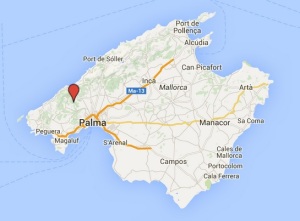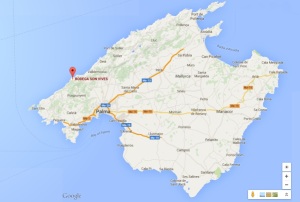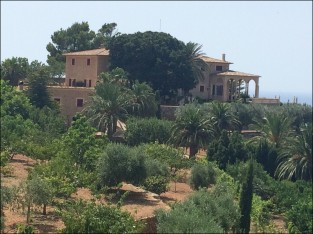“Hidden away in a mountain valley, this precious jewel is worth every second spent searching for it.”

http://www.esverger.es
Esporles, Mallorca Spain
The award winning Es Verger is a small, privately owned and run boutique winery. They have 7 hectares of vineyards on this magical mountain property, and all production is done on site. Originally planted in 1995, the first wines went to market in 2001. They produce approximately 15,000 bottles per year; their wine is certified organic, and sold primarily to an international market and fine local restaurants. They produce 3 reds, a rosé, and a very special sweet white.
So, after we left Celler Son Vives, we called Es Verger to see if they were open, since we had to drive through Esporles anyway to get out of the mountains. Friday night – 5:30 – what are the chances? A man answers the phone “Sure, come on over… I’m here.” And we are off to the next Winery!
Es Verger is situated way up in the Tramuntana hills above Esporles, accessed only by a small, beautiful, and winding road with hidden or invisible street signs. After a few more phone calls – in Spanish of course – we get directions by landmark: “In direction Palma, third right after the plaza, climb, wind, until the big tree in the middle of the road… then…” Unsure if we were on the right road the entire time… looking at the clock and thinking perhaps we don’t have time for this… and then, 4.5km winding through the mountain… there he is – the man on the other end of the phone – waving us down to stop at his gorgeous stone walled vineyard. It felt like we were in a summer dream…

Miguel, the owner and vintner, welcomed us onto his property through his stone pillared gate. Lean, tan, white haired and wearing shorts and a loose, pressed white cotton shirt, he walked us past his beautiful vine covered home amidst gentle sounds of young voices and tapping earthen kitchenware, and to the adjoining Bodega. Inside, the cool air greeted us, and the now familiar steel fermenting tanks lined one wall as we passed through to the tasting area. The first thing we notice were all the awards and certificates that are proudly, yet discretely, framed on the wall. For some strange reason, this did not mean anything to us, and we had no expectations before the tasting. Surrounded by maturing bottles, and speaking to us only in Spanish, Miguel brought out 5 bottles of wine, two glasses, and an elegant small bottle of light virgin olive oil.
Pouring the first taste, Miguel starts telling us about his wine and how he makes it. He started the vineyard out of passion and interest, and only wants to make good wine. Producing around 15,000 bottles per year, they are mostly exported, or sold in high-class restaurants on the island and to private clients. After the first taste we love it! It is clear that this is his passion and that he makes the wine that he wants to drink. While we tasted, his daughters appeared, earnest and beaming, bringing rock salt and sliced rustic bread to frame the home pressed oil that is also for sale. The oil was lovely, light and delicate, a very welcome addition to the tasting and delicious! We tried four of the five bottles of wine; the only one we didn’t try is the Pinot Noir, because of demand it has sold out.
Please see our tasting notes for more detail on the wines.
Trying to let Miguel get back to his family, we asked him to show us his vineyards on the way back to our car. We walked along the stunningly healthy vines planted carefully in their lines, all certified and organically tended. Miguel explained that they plant their rows farther apart than standard because of the mountainous terrain, and the sun and air between the rows largely prevents disease. He told us more sun produces thicker skin, thus more flavor and tannins, becoming full bodied in fermentation. Tannins are textural, and the perfect astringency in the mouth seems to make a wine ‘taste dry.’ 8-10 days steeping with the skins creates the flavor; the ripe inside fruit providing the water and sugar for successful fermentation.
All Es Verger wines are produced thoughtfully, with high personal standards, and are ecologically tended and certified organic = subject to the strict regulations of the Island Council’s CBPAE body (Consell Balear Regulador de l’Agricultura Ecològica). These delicious wines deserve the recognition received, and our tasting visit was characteristic of the quality at Es Verger … a summer dream come true!
Open Sesame
Through the rabbit hole
Finding passion, friendship
A desire for perfection
A jewel of Mallorca
 How to get there: When you come from Palma to Esporles, you will see a sign for Es Verger on the left. Take that turn and follow the road for 4.5km. It is a long winding road out of town. Keep driving until you get to a tree in the middle of the road. At this fork take the left where it says Es Verger.
How to get there: When you come from Palma to Esporles, you will see a sign for Es Verger on the left. Take that turn and follow the road for 4.5km. It is a long winding road out of town. Keep driving until you get to a tree in the middle of the road. At this fork take the left where it says Es Verger.
See Wines Tasted at Es Verger: Click here
### ES VERGER ###

























